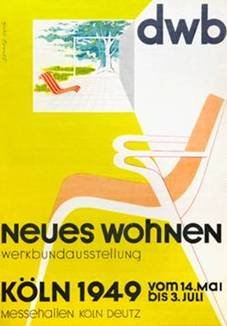100 Years German Werkbund
dal 17/4/2007 al 25/8/2007
Segnalato da
17/4/2007
100 Years German Werkbund
Architekturmuseum, Munich
Art, Works on paper, architecture and design. The show presents one of the most important chapters of German cultural and economic history of the 20th century by means of ca. 500 exhibits. Posters, models, furniture, design, drawings and photographs show in a vivid manner the achievements of the German Werkbund.

Art, Works on paper, architecture and design
In October 1907, twelve artists and architects, among them Peter Behrens,
Josef Hoffmann and Richard Riemerschmid, as well as twelve companies in
Munich joined together to found the German Werkbund. According to the
founding members the intended purpose was "the refinement of arts and crafts
in collaboration with art institutions, industry and craftsmen’s trade
organisations by means of education, propaganda and unanimous statements on
any relevant issues". The objective of "refining" the entire industrialized
environment "from sofa cushion to urban design" (Hermann Muthesius)
according to artistic aspects, and the cultural "education" of the populace
by means of well-formed objects characterized the work of the German
Werkbund up to the last third of the 20th century. If companies today try to
create a consistent appearance, a corporate identity, if there is a general
appreciation concerning the design of industrial products, if "industrial
design" is taught at universities, developed by enterprises and shown in
museums, then this has to be regarded primarily as the Werkbund’s credit.
Some of the most famous German artists and architects of the 20th century
belonged to the German Werkbund, and Werkbund exhibitions, such as "The
Form" (1924), "Film and Photography" (1929) or the Werkbund housing estates
were milestones in the development of new forms expressing a world changed
by industry and technology. To this day, the Weissenhof housing estate in
Stuttgart of 1927, organized by the Werkbund with buildings of Le Corbusier,
Mies van der Rohe, J. J. P. Oud or Hans Scharoun rank among the most
outstanding and internationally renowned examples of modern architecture of
the 20th century. Following the Stuttgart housing experiment, some further
Werkbund estates were estblished in Brünn (1928), Breslau (1929), Prague
(1932), Neubühl (1932) and Vienna (1932), thus creating housing and urban
design models for the modern human being.
In the twenties the German Werkbund played a leadership role in the most
important experiments concerning design for a forthcoming world that would
be characterized by technology, internationality and mobility. After the
political alignment during the Nazi-regime, a major Werkbund exhibition was
organized in Cologne already in 1949, to provide regulations and criteria
for the post-war reconstruction. In this context, the contribution of the
Swiss Werkbund, Max Bill’s trend-setting show "Good design" was to become
the motto for the following decades. The Werkbund concept for the German
pavilion at the World Fair in Brussels in 1958 gained international
recognition.
It was during the Werkbund meeting on "The large-scale land destruction" in
Marl in 1959, when the German Werkbund turned its attention to topics such
as "urban sprawl" and "ecological destruction", thus triggering decisive
impulses for the development of a public awareness regarding ecology and the
consequences of a reckless economic growth. More and more the Werkbund’s
interest now turned towards the problems of usage rather than the question
of production itself. It was not the "good design" anymore, that was at the
forefront, but the appropriate handling of products and the consequences of
consumption. The Werkbund changed from an ethic community to an action group
with an admonitory and inspiring effect to this day.
The exhibition "100 Years German Werkbund", which the Architekturmuseum der
TU München (Museum of Architecture at the Technical University of Munich)
has compiled in close cooperation with the Technische Universität Darmstadt,
Fachgebiet Geschichte und Theorie der Architektur (GTA) (Technical
University of Darmstadt, Department of History and Theory of Architecture),
Die Neue Sammlung - State Museum of Applied Arts and Design I Design in the
Pinakothek der Moderne, Munich and the Institut für Auslandsbeziehungen
(Institute for Foreign Cultural Relations) (ifa), Stuttgart, presents one of
the most important chapters of German cultural and economic history of the
20th century by means of ca. 500 exhibits. Posters, models, furniture,
design, drawings and photographs show in a vivid manner the achievements of
the German Werkbund. Subsequently, the exhibition will be shown at the
Akademie der Künste (Academy of Arts), Berlin, Hanseatenweg, from 16
September to 11 November 2007. Accompanying the exhibition is a catalogue
published by Prestel Verlag. It has 384 pages and about 700 mainly colour
illustrations and is on sale in the museum shop at the price of circa 38
Euros.
Press preview: 18.04.2007, 11.00
Opening: 18.04.2007, 19.00
Architekturmuseum der TU München in the Pinakothek der Moderne
Arcisstr. 21 - München



